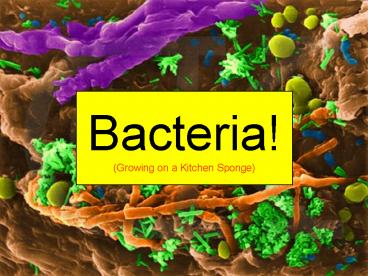Bacteria! (Growing on a Kitchen Sponge) - PowerPoint PPT Presentation
1 / 44
Title:
Bacteria! (Growing on a Kitchen Sponge)
Description:
Diseases: tetanus, botulism, gonorrhea, chlamydia, tuberculosis, etc., etc., etc. ... Diseases: tetanus, botulism, gonorrhea, chlamydia, tuberculosis, etc. ... – PowerPoint PPT presentation
Number of Views:315
Avg rating:3.0/5.0
Title: Bacteria! (Growing on a Kitchen Sponge)
1
Bacteria!(Growing on a Kitchen Sponge)
2
Cutting Board (Eubacteria)
3
Diversity of Life
4
Bacterial Diversity
Description procaryotes, absorbers, wet
conditions, animal decomposers, cell walls,
unicellular Types eubacteria, archaeabacteria,
Gram-negative, Gram-positive, acid fast,
cyanobacteria Morphology cocci, bacilli,
spirals, etc. Nutrient Type chemoheterotrophs,
photoheterotrophs, chemoautotrophs,
photoautotrophs (also O2 needs, etc.) Durable
state endospores (some) Diseases tetanus,
botulism, gonorrhea, chlamydia, tuberculosis,
etc., etc., etc.
5
Bacterial Diversity
Description procaryotes, absorbers, wet
conditions, animal decomposers, cell walls,
unicellular Types eubacteria, archaeabacteria,
Gram-negative, Gram-positive, acid fast,
cyanobacteria Morphology cocci, bacilli,
spirals, etc. Nutrient Type chemoheterotrophs,
photoheterotrophs, chemoautotrophs,
photoautotrophs (also O2 needs, etc.) Durable
state endospores (some) Diseases tetanus,
botulism, gonorrhea, chlamydia, tuberculosis,
etc., etc., etc.
6
Bacteria Morphological Diversity
From http//ag.arizona.edu/plp/courses/plp329/micd
ivintro.ppt
7
Bacterial Diversity
Description procaryotes, absorbers, wet
conditions, animal decomposers, cell walls,
unicellular Types eubacteria, archaeabacteria,
Gram-negative, Gram-positive, acid fast,
cyanobacteria Morphology cocci, bacilli,
spirals, etc. Nutrient Type chemoheterotrophs,
photoheterotrophs, chemoautotrophs,
photoautotrophs (also O2 needs, etc.) Durable
state endospores (some) Diseases tetanus,
botulism, gonorrhea, chlamydia, tuberculosis,
etc., etc., etc.
8
Bacterial Phylogeny
9
Cyanobacteria
10
Bacterial Phylogeny
11
Archaebacteria
12
Thermophiles (Archaeabacteria)
13
Bacterial Diversity
Description procaryotes, absorbers, wet
conditions, animal decomposers, cell walls,
unicellular Types eubacteria, archaeabacteria,
Gram-negative, Gram-positive, acid fast,
cyanobacteria Morphology cocci, bacilli,
spirals, etc. Nutrient Type chemoheterotrophs,
photoheterotrophs, chemoautotrophs,
photoautotrophs (also O2 needs, etc.) Durable
state endospores (some) Diseases tetanus,
botulism, gonorrhea, chlamydia, tuberculosis,
etc., etc., etc.
14
Bacterial Anatomy (Overview)
15
Bacterial Motility
16
Nucleoid
17
Microbial Growth
Because individual cells grow larger only to
divide into new individuals, microbial growth is
defined not in terms of cell size but as the
increase in the number of cells, which occurs by
cell division."
18
Binary Fission
19
Endospores
20
Bacterial Diversity
Description procaryotes, absorbers, wet
conditions, animal decomposers, cell walls,
unicellular Types eubacteria, archaeabacteria,
Gram-negative, Gram-positive, acid fast,
cyanobacteria Morphology cocci, bacilli,
spirals, etc. Nutrient Type chemoheterotrophs,
photoheterotrophs, chemoautotrophs,
photoautotrophs (also O2 needs, etc.) Durable
state endospores (some) Diseases tetanus,
botulism, gonorrhea, chlamydia, tuberculosis,
etc., etc., etc.
21
Procurement of C Energy
The Basic Nutritional Needs of Organisms are for
Energy and for Carbon
We can distinguish procurement strategies into
- Autotrophic (C)
- Heterotrophic (C)
- Phototrophic (energy)
- Chemotrophic (energy)
22
Autotrophs Eat CO2
23
Heterotrophs Eat Others
?
(except cyanobacteria certain
archaebacteria, e.g., such as those that eat
whale sulfides)
(all but photosynthetic most protozoa algae)
24
Phototrophs Eat Light
25
Chemotrophs Eat Reduced Molecules
26
Chemotrophs Eat Reduced Molecules
?
(except cyanobacteria green purple non-sulfur
bacteria)
(all but photosynthetic most protozoa algae)
27
(No Transcript)
28
Nutritional Patterns
29
Oxygen Requirements
30
Bacterial Diversity
Description procaryotes, absorbers, wet
conditions, animal decomposers, cell walls,
unicellular Types eubacteria, archaeabacteria,
Gram-negative, Gram-positive, acid fast,
cyanobacteria Morphology cocci, bacilli,
spirals, etc. Nutrient Type chemoheterotrophs,
photoheterotrophs, chemoautotrophs,
photoautotrophs (also O2 needs, etc.) Durable
state endospores (some) Diseases tetanus,
botulism, gonorrhea, chlamydia, tuberculosis,
etc., etc., etc.
31
Bacteria Nitrogen Cycling
32
Bacterial Diversity
Description procaryotes, absorbers, wet
conditions, animal decomposers, cell walls,
unicellular Types eubacteria, archaeabacteria,
Gram-negative, Gram-positive, acid fast,
cyanobacteria Morphology cocci, bacilli,
spirals, etc. Nutrient Type chemoheterotrophs,
photoheterotrophs, chemoautotrophs,
photoautotrophs (also O2 needs, etc.) Durable
state endospores (some) Diseases tetanus,
botulism, gonorrhea, chlamydia, tuberculosis,
etc., etc., etc.
33
Symbiosis
- Symbioses are intimate, relatively long-term
interaction between organisms - Typically at least one of the organisms benefits
from the relationship - We can classify Symbioses in terms of the degree
to which the other organism (e.g., the host)
benefits or is harmed - Commensalism
- Mutualism
- Parasitism
34
Bacterial Diseases
35
Toxins
- Toxins
- Chemical (often protein) agents that damage
host tissue - Endotoxins
- Lipid A portion of LPS (not protein) that
causes host overreaction - Exotoxins
- Protein toxins, typically produced by
Gram-positives as exoenzymes or equivalents - But also many Gram-negatives
- Neurotoxins, Enterotoxins
- Intoxication
- Toxoid
36
Bacterial Cell Walls
37
Kochs Postulates
38
Kochs Molecular Postulates
- Gene or factor should be associated with
pathogenic condition or phenotype - Inactivate or alter this gene should lead to
measurable decrease in virulence or pathogenicity
(e.g., via antibody therapy, chemotherapy, or
genetic engineering) - Specifically replace gene should restore virulence
Adapted from http//www.med.umich.edu/microbio/pp
t/532_11prevcontrol.ppt
39
Link to Next Presentation
40
Acknowledgements
http//207.233.44.253/w
41
Kitchen Sponge (Eubacteria)
42
Thermophiles
A large channel draining from a hot pool,
containing carotenoid-rich microorganisms. The
temperature of this channel in the foreground is
about 60 oC. Layers of white-coloured limestone
(forming a rock deposit known as travertine) can
also be seen. Note the footprints of buffalo in
the foreground. These animals often seek the
warmth of thermal areas in the winter months.
limestone terraces formed by precipitation from
calcium-rich water flowing from a raised hot
pool. Pink, green and brown-coloured
microorganisms occupy the thermal gradients in
the flowing water (60-100oC)
43
Bacterial Anatomy (Overview)
44
Bacterial Phylogeny































